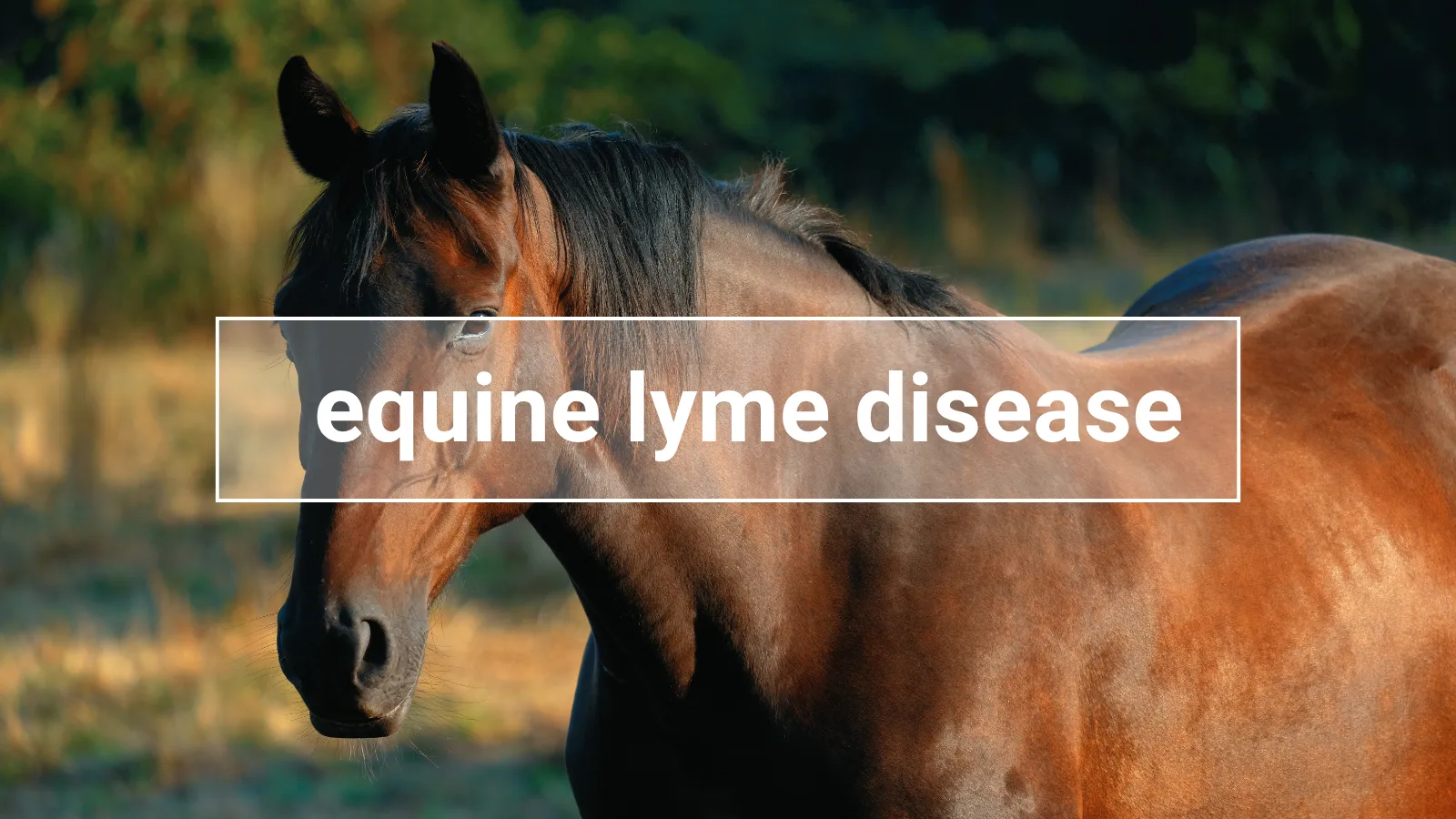
Equine Lyme Disease: Symptoms, Treatment, and Prognosis
Lyme disease in horses is a tricky tick-borne illness caused by Borrelia burgdorferi. Because the signs of lyme disease in horses are often non-specific, it can be a challenge to detect. This article covers how to recognize the condition, how it is diagnosed and treated, and how to protect your horse effectively.
Table of Contents
What Is Equine Lyme Disease and How Does It Affect Horses?
Also known as Lyme borreliosis, equine lyme disease is a bacterial infection caused by Borrelia burgdorferi, transmitted almost exclusively through tick bites. Once bitten, the bacteria can enter the bloodstream and settle in various tissues including joints, nerves, skin, and muscles.
The disease is difficult to detect since the symptoms of lyme disease in horses are non-specific and often mistaken for other conditions. Studies show many horses have antibodies against Borrelia without showing clinical signs, making the true prevalence unclear. However, in tick-endemic areas, lyme disease in horses is increasingly recognized as a significant risk.
Causes and Risk Factors of Lyme Disease in Horses
Transmission occurs through bites from infected ticks, primarily the castor bean tick (Ixodes ricinus). Horses that spend a lot of time on pastures, especially in moist or wooded areas, are at increased risk.
Key risk factors:
- Living in tick-dense areas
- Pasture access during spring and summer
- Weakened immune system
- Pre-existing health issues
Signs of Lyme Disease in Horses
The biggest challenge is identifying the disease in the first place. Unlike in humans, the typical "bull’s-eye" rash is rarely seen in horses. Instead, the disease often progresses subtly and slowly.
Common equine lyme disease symptoms:
- Shifting leg lameness
- Lethargy and lack of motivation
- Neurological lyme disease in horses, including incoordination or ataxia
- Swelling in joints
Symptoms tend to fluctuate, making diagnosis even more difficult.
Detailed Overview of Symptoms of Lyme Disease in Horses
Lameness & Joint Issues
Horses may develop uneven gaits or lameness that shifts from one leg to another. Recurring joint inflammation is common.
Neurological Symptoms & Ataxia
In severe cases, the bacteria may affect the nervous system. This can lead to coordination problems and full-blown neurological lyme disease in horses.
Skin Changes
Rarely, horses show skin issues or slow-healing wounds.
General Symptoms
- Fatigue and apathy
- Reduced performance
- Muscle stiffness
- Weight loss
Equine lyme disease test
Diagnosing lyme disease in horses is complex due to the vagueness of symptoms. Other conditions must first be ruled out.
Diagnostic methods include:
- Clinical examination by a veterinarian
- Blood tests: ELISA and Western Blot can detect antibodies but don’t confirm active infection
- Cerebrospinal fluid analysis (for neurological signs)
- Differential diagnostics to rule out parasites, metabolic, or orthopedic issues
A positive antibody test merely confirms past exposure — not an active infection.
Treatment of Lyme Disease in Horses
Treatment depends on the stage and severity of the illness.
Antibiotic Therapy
- Commonly used: Doxycycline or Oxytetracycline
- Treatment lasts several weeks
- Outcomes vary: some horses recover well, others experience relapses
Supportive Care
- Physiotherapy for muscle tension
- Supplements to boost immune function
- Rest during acute lameness episodes
Alternative Therapies
Some owners use herbal or homeopathic remedies, although their effectiveness lacks scientific proof.
Case Reports on Equine Lyme Disease Treatment
- Some horses become symptom-free after antibiotics
- Others face recurring flare-ups
- Some test positive but never show symptoms
Long-Term Outlook and Equine Lyme Disease Prognosis
The answer is nuanced. While treatment of lyme disease in horses can be effective, complete recovery isn’t always possible.
Early-stage detection offers the best equine lyme disease prognosis. In chronic cases, Borrelia can survive in joints or nerve tissue, triggering relapses. Repeated treatment may be required.
The goal is often not full eradication but long-term symptom management and maintaining quality of life.
How to Prevent Lyme Disease in Horses Effectively
Tick Control
- Daily coat checks after turnout
- Use of insect repellents
- Keeping pastures trimmed
Boosting the Immune System
Vitamins, minerals, and herbal supplements can help strengthen resistance to infection.
Vaccination
Currently, there is no approved equine vaccine for Lyme disease. However, maintaining an up-to-date vaccination schedule for other illnesses is vital.
Related Conditions That Mimic Lyme Disease in Horses
Due to the variety of symptoms, differential diagnosis is crucial.
- Parasites can cause similar signs like poor performance and lameness
- Ataxia may stem from multiple neurological causes
Conclusion: Early Detection and Targeted Lyme Disease in Horses Symptoms Treatment
Lyme disease in horses is a serious and often elusive condition. Hallmark signs include fluctuating lameness, fatigue, and neurological impairments. Prompt diagnosis and treatment significantly affect the prognosis of equine lyme disease.
Though full recovery may not always be achievable, with the right mix of antibiotics, supportive therapy, and attentive care, many horses can lead healthy, active lives.
Equine Lyme Disease: FAQs
What is equine lyme disease?
A bacterial infection caused by Borrelia burgdorferi, transmitted by ticks, affecting joints, nerves, and muscles.
What are the symptoms of lyme disease in horses?
Primarily shifting lameness, low energy, and occasional neurological issues.
How do symptoms of lyme disease in horses progress?
Early signs are vague; chronic stages may involve joint inflammation, ataxia, or persistent health issues.
Is there a cure for equine lyme disease?
Early treatment yields good outcomes. In chronic cases, long-term management is often required.
What are the treatment options?
Antibiotics, combined with physiotherapy and immune support.
How common is lyme disease in horses?
Serology shows many horses are exposed, but fewer develop clinical symptoms.

